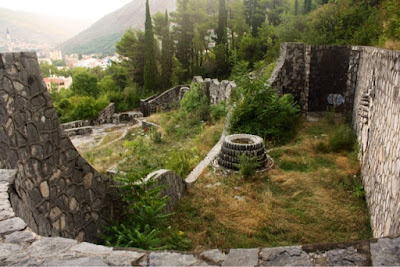Sadly bidding Croatia goodbye, we began the next leg of our journey, entering into Montenegro which admittedly was beautiful in its own right. We began in the town of Herceg Novi. After a sweat-educing walk up hill, we surveyed the beautiful views and enjoyed wandering around the fortress (free entrance! Although I don't think it was meant to be. Woops)
Rather exhausted by the heat, we retired to the shade of some palm trees for a cold drink. The church next to us was emitting some solemn sounding chanting and when we walked past I noticed a man and a woman standing before a priest each holding an extremely large candle. Some sort of interesting local custom perhaps?
There was little else to see in the little town so we headed off to our next destination. We were in search of a lovely sounding restaurant but Montenegro's road signs proved to be as elusive as Croatia's and no matter how hard we searched we couldn't find it. All was well however as we found a bakery with Burek and had an impromptu picnic by the water. After our tranquil lunch we decided to go in search of a beach (notice a re-occurring theme here!) and settled by this little bay that we had almost to ourselves, the water almost as good as Croatia. Some elderly locals had their chairs out on the wharf and were drinking beers together. Not a bad way to spend your retirement!
Reluctantly we left the beach behind as the day began to cool and headed for the town of Risan. After settling in to our spacious and cheap apartment, we headed off to see the town's big attraction, the Roman mosaics. During Rizan's most prosperous time in the 1st and 2nd centuries the Roman's built resplendent villas - almost the only vestige of this wealth that remains are these beautiful mosaics which were built sometime in the 2nd century and were used until the 4th century.
These mosaics were discovered in the 1930s and thought to be part of a Villa. One of the most interesting mosaics found was this one, featuring the Roman god of sleep -Hypnos- in the middle. Although named a Villa by the original excavators, later research deduced that this building was in fact an hotel built at the crossroads of the street leading down to the harbor. Additional excavations carried out in this area have yielded interesting finds, including a coin hoard and a large variety of Greek amphorae and bronze nails. The information board mentioned that research into these finds was currently being undertaken.
The next day we carried on as there was little else to do in Risan. Our next destination was the town of Perast. One of the notable things about this town is how close it lies to two islands, one natural and the other man-made. The natural island is impossible for tourists to get to as it has a still running monastery - I'm glad those who live there get to spend their time in relative peace, but I feel bad that their tranquility must be constantly disturbed by tourists in boats heading to the nearby artificial island.
Once part of the Venetian republic, the architecture and churches were reminiscent of this style which I very much enjoyed. However pretty as it was, it was also teeming with tourists so after a pleasant wander we soon left.
The view from the town as we headed out, looking back it again struck me as very picturesque and pretty.
We then headed for the town of Kotor, the main town in the bay. The drive there afforded us with stunning views and it's at times like this I feel so lucky to have traveled with a car rather than having been stuck on main transport routes by train or bus.









































